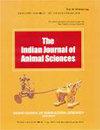添加外源纤维分解酶对断奶杂交犊牛自愿摄食量、营养物质利用率和生长性能的影响
IF 0.3
4区 农林科学
Q4 AGRICULTURE, DAIRY & ANIMAL SCIENCE
引用次数: 0
摘要
本试验旨在研究添加外源纤维分解酶(EFE)对断奶杂交犊牛自愿采食量、不同营养物质利用率和生长性能的影响。断奶健康泽西杂交母犊牛15头(体重79.73±3.46 kg);年龄234.5±11.33 d),随机分为对照组(T0)、治疗1组(T1)和治疗2组(T2)。对这些犊牛进行90 d的生长试验。各处理组采用自由饲喂。总混合日粮(TMR) (CP 12%, TDN 65%)分别饲喂90 d。对照组(T0)犊牛自由饲喂。TMR(不含EFE)。T1和T2期犊牛自由饲喂。在TMR中分别添加EFE纤维素酶和木聚糖酶8000和16000 IU/kg DM, EFE纤维素酶和木聚糖酶12000和24000 IU/kg DM。酶添加组单位体重DMI (kg/100 kg BW和g/kg W0.75)显著高于对照组;然而,T1与T2之间的差异无统计学意义。犊牛TMR饲粮中添加EFE, T1和T2阶段TDN和DCP摄入量(g/kg W0.75)均高于T0。饲粮中添加EFE也显著提高了T1和T2阶段饲粮的TDN(%)、DCP(%)、DNDF(%)、DE (Mcal/kg饲料)和ME (Mcal/kg饲料)值。估计T1和T2的平均日增重(g/d/头)大于T0。3个处理的饲料转化率基本一致。饲粮中添加EFE可显著提高犊牛血浆总蛋白和白蛋白浓度。由此可见,饲粮中添加8000和16000 IU/kg TMR DM的外源纤维分解酶(纤维素酶和木聚糖酶)可提高育肥猪泽西杂交犊牛的生长潜力。本文章由计算机程序翻译,如有差异,请以英文原文为准。
Effect of exogenous fibrolytic enzymes supplementation to improve voluntary intake, availability of nutrients and growth performance in weaned crossbred calves
The present study was carried out to evaluate the effect of supplementation of exogenous fibrolytic enzymes (EFE) on voluntary feed intake, availability of different nutrients and growth performance in weaned crossbred calves. Fifteen weaned healthy female Jersey crossbred calves (weight 79.73±3.46 kg; age 234.5±11.33 days) were divided equally into three groups viz., Control (T0), Treatment-1 (T1) and Treatment-2 (T2). Growth trial was conducted on these calves for 90 days. Animals in each treatment group were fed ad lib. total mixed ration (TMR) (CP 12%, TDN 65%) individually for 90 days. Calves under control (T0) group were fed ad lib. TMR (without EFE). Calves under T1 and T2 were fed ad lib. TMR supplemented with EFE cellulase and xylanase @ 8000 and 16000 IU/kg DM of TMR and with EFE cellulase and xylanase @ 12000 and 24000 IU/kg DM of TMR, respectively. Significantly greater DMI per unit body weight (kg/100 kg BW and g/kg W0.75) was recorded in enzyme supplemented groups compared to control group; however, difference between T1 and T2 was non-significant. Addition of EFE in the TMR diet of calves increased TDN and DCP intake (g/kg W0.75) in T1 and T2 than T0 . Supplementation of EFE also enhanced TDN (%), DCP (%), DNDF (%), DE (Mcal/kg of feed) and ME (Mcal/kg of feed) value of the diets under T1 and T2 than T0. Average daily weight gain (g/d/calf) was estimated greater in T1 and T2 than T0. The feed conversion efficiency was similar among three treatments. Whereas, plasma total protein and albumin concentration increased significantly due to supplementation of EFE in the diet of calves. Therefore, it may be concluded that supplementation of exogenous fibrolytic enzymes (cellulase and xylanase @ 8000 and 16000 IU/kg TMR DM) may boost growth potential of finisher Jersey crossbred calves with enhanced intake of nutrients.
求助全文
通过发布文献求助,成功后即可免费获取论文全文。
去求助
来源期刊

Indian Journal of Animal Sciences
农林科学-奶制品与动物科学
CiteScore
0.60
自引率
25.00%
发文量
220
审稿时长
8 months
期刊介绍:
Articles published in The Indian Journal of Animal Sciences encompass a broad range of research topics in animal health and production related to cattle, buffalo, sheep, goat, camel, equines, pig, rabbit, yak, mithun, poultry and fisheries. Studies involving wildlife species and laboratory animal species that address fundamental questions about their biology will also be considered for publication. All manuscripts must present some new development and must be original, timely, significant and scientifically excellent. Papers will be rejected if standards of care of, or procedures performed on animals are not up to those expected of humane veterinary scientists. At a minimum, standards must meet the International Guiding Principles for Biomedical Research involving Animals, as issued by the Council for International Organizations of Medical Sciences. (C.I.O.M.S., c/o WHO, CH 1211 Geneva 27, Switzerland). Articles reporting new animal disease must follow GOI directive as given in detail in Guidelines to Authors.
 求助内容:
求助内容: 应助结果提醒方式:
应助结果提醒方式:


